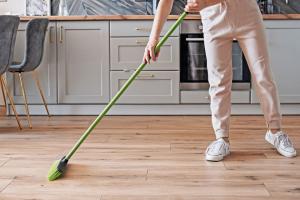Mastering the Art of Sweeping: Expert Tips for Removing Dirt & Debris

-
Quick Links:
- Introduction
- Understanding Sweeping
- Tools Required for Sweeping
- Step-by-Step Sweeping Techniques
- Common Mistakes to Avoid While Sweeping
- Maintenance Tips for Sweeping Tools
- Case Studies: Success Stories in Floor Cleaning
- Expert Insights on Effective Sweeping
- Conclusion
- FAQs
Introduction
Sweeping is often perceived as a simple chore, yet mastering the art of sweeping can significantly impact the cleanliness and hygiene of your living space. This comprehensive guide dives deep into the best practices for sweeping floors effectively, ensuring you can remove dirt and debris with ease and efficiency.
Understanding Sweeping
Sweeping involves the use of a broom to collect dirt, dust, and debris from the floor. While it may seem straightforward, understanding the underlying principles of sweeping can enhance your technique and results. Sweeping not only improves aesthetics but also contributes to a healthier environment by reducing allergens and contaminants.
Tools Required for Sweeping
To achieve optimal results while sweeping, the right tools are essential. Here’s a list of commonly used tools:
- Broom: Choose a broom with bristles suitable for your floor type (hardwood, tile, etc.). For outdoor use, a stiff broom is preferable.
- Dustpan: A sturdy dustpan helps collect the debris without spilling.
- Vacuum Cleaner: While not traditional, a vacuum can complement sweeping, especially for fine dust.
- Mop: For finishing touches, especially in kitchens and bathrooms.
Step-by-Step Sweeping Techniques
Follow these steps to sweep effectively:
Step 1: Prepare the Area
Remove furniture and obstacles to create a clear space. This allows you to sweep without interruptions.
Step 2: Choose the Right Broom
Select a broom that matches the surface of your floor. Soft bristles work best on smooth surfaces, while stiff bristles are effective on rough surfaces.
Step 3: Sweep in Sections
Divide the area into smaller sections. Sweep each section methodically from one side to the other, ensuring no debris is missed.
Step 4: Use Proper Technique
Hold the broom at a slight angle and use short, controlled strokes. This technique helps gather dirt more effectively.
Step 5: Collect Debris
Use the dustpan to collect the swept debris. Ensure you angle the dustpan correctly to avoid spills.
Step 6: Final Touches
For thorough cleaning, follow up with a damp mop to pick up any remaining dust particles.
Common Mistakes to Avoid While Sweeping
Even seasoned cleaners can make mistakes when sweeping. Here’s a list of common errors:
- Not sweeping in sections, which can lead to missed spots.
- Using the wrong type of broom for the floor surface.
- Forgetting to clean the dustpan.
Maintenance Tips for Sweeping Tools
Proper maintenance extends the life of your sweeping tools. Here are some maintenance tips:
- Clean your broom regularly by removing hair and debris from the bristles.
- Store brooms upright to maintain their shape.
- Replace worn-out brooms to ensure effective cleaning.
Case Studies: Success Stories in Floor Cleaning
Numerous households have transformed their cleaning routines through effective sweeping techniques. For instance, a family in Springfield reported a 50% reduction in dust allergies after implementing a daily sweeping schedule. Such case studies provide real-world evidence of the importance of proper sweeping.
Expert Insights on Effective Sweeping
We consulted cleaning experts who emphasized the importance of technique and consistency in sweeping. They recommend creating a sweeping schedule and adhering to it for optimal results.
Conclusion
Sweeping is more than just a chore; it’s an essential practice for maintaining a clean and healthy home. By following the expert tips and strategies outlined in this guide, you can master the art of sweeping and ensure your floors remain free of dirt and debris.
FAQs
1. How often should I sweep my floors?
It depends on foot traffic, but generally, sweeping daily or every other day is recommended for high-traffic areas.
2. What type of broom is best for hardwood floors?
A soft-bristled broom is ideal for hardwood floors to avoid scratches.
3. Can I use a vacuum instead of sweeping?
Yes, a vacuum can be effective, especially for picking up fine dust and debris.
4. Should I sweep before mopping?
Yes, always sweep before mopping to remove dirt and debris.
5. How do I prevent dust from settling after sweeping?
Consider using a damp mop or microfiber cloth after sweeping to trap dust.
6. Is it beneficial to use a dust mask while sweeping?
Yes, a dust mask can help prevent inhalation of dust and allergens.
7. How can I make sweeping easier?
Organize your space, use the right tools, and sweep in sections for efficiency.
8. What should I do with the debris after sweeping?
Dispose of it in the trash or compost if appropriate.
9. Can I sweep outdoors?
Yes, but use a broom designed for outdoor use, as it is sturdier.
10. How do I know when to replace my broom?
If you notice the bristles are worn out or no longer effective in collecting debris, it’s time for a replacement.